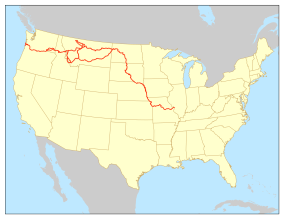Lewis and Clark National Historic Trail
| Lewis and Clark National Historic Trail | |
|---|---|
|
IUCN category V (protected landscape/seascape) | |
 | |
| Location | IL, MO, KS, IA, NE, SD, ND, MT, ID, OR, and WA, USA |
| Nearest city | Omaha, NE |
| Coordinates | 41°0′0″N 96°0′0″W / 41.00000°N 96.00000°WCoordinates: 41°0′0″N 96°0′0″W / 41.00000°N 96.00000°W |
| Established | November 10, 1978 |
| Visitors | 250,000 (in 2004) |
| Administrator | National Park Service |
| Website | http://www.nps.gov/lecl |
The Lewis and Clark National Historic Trail is a route across the United States commemorating the Lewis and Clark Expedition of 1804 to 1806. It is part of the National Trails System of the United States. It extends for some 3,700 miles (6,000 km) from Wood River, Illinois, to the mouth of the Columbia River in Oregon.
The trail is administered by the National Park Service, but sites along the trail are managed by federal land management agencies, state, local, tribal, and private organizations. The trail is not a hiking trail, but provides opportunities for hiking, boating and horseback riding at many locations along the route. The trail is the second longest of the 23 National Scenic and National Historic Trails. Beginning at the Camp Dubois recreation in Illinois, it passes through portions of Missouri, Kansas, Iowa, Nebraska, South Dakota, North Dakota, Montana, Idaho, Oregon, and Washington.
Headquarters and visitor center

The official headquarters for the trail is located at the National Park Service Midwest Regional Headquarters, in Omaha, Nebraska. The visitor center features exhibits about the explorers and their historic trip, as well as information about sites along the trail.
History
In 1948 the National Park Service proposed a "Lewis and Clark Tourway" along the Missouri River from St. Louis to Three Forks, Montana. Later, Jay "Ding" Darling proposed the development of the expedition route as a recreational trail. Following a 1966 report by the Bureau of Outdoor Recreation, the National Trails System Act of 1968 listed the route for study as a possible National Scenic Trail. Finally in 1978 the law was amended by the National Parks and Recreation Act to provide for a new category of trail, National Historic Trails, one of which was to be the Lewis and Clark trail.[1] From 2003 to 2006, the National Park Service commemorated the bicentennial of the Lewis and Clark Expedition with the Corps of Discovery II traveling exhibit.[2]
References
- Bassman, John H. (2009). A navigation companion for the Lewis & Clark Trail. Volume 1, History, camp locations and daily summaries of expedition activities. United States: John H. Bassman.
- National Park Service (1978). Lewis and Clark National Historic Trail Comprehensive Plan for Management and Use. United States: United States Department of the Interior.
External links
| Wikimedia Commons has media related to Lewis and Clark National Historic Trail. |
- Lewis and Clark National Historic Trail (National Park Service)
- Lewis and Clark Trail Heritage Foundation
- Lewis and Clark Trust
- lewisandclarktrail.org